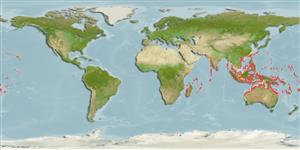Environment: milieu / climate zone / depth range / distribution range
ນິເວດວິທະຍາ
ສັດທະເລ ກ່ຽວກັນຫີນ; ລະດັບຄວາມເລິກ 0 - 30 m (Ref. 5213). Tropical; 29°N - 34°S, 28°E - 157°W (Ref. 5222)
Indo-West Pacific: Natal, South Africa to the central Pacific. Not known from the Red Sea nor Persian Gulf.
ຂະໜາດ / ນ້ຳໜັກ / Age
Maturity: Lm ? range ? - ? cm
Max length : 54.9 cm TL ຕົວຜູ້/ບໍ່ມີເພດ; (Ref. 125599); common length : 25.0 cm TL ຕົວຜູ້/ບໍ່ມີເພດ; (Ref. 9137); ນ້ຳໜັກສູງສຸດທີ່ເຄຍຈັດພີມມາ: 3.8 kg (Ref. 125599)
ຄີ (ໜາມ)ແຂງຢູ່ຫຼັງປາ (ທັງໝົດ) : 11; ຄີຫຼັງຂອງປາ (ຄີອ່ອນ) (ທັງໝົດ) : 14 - 16; ຄີ(ໜາມ) ແຂງຢູ່ຄີກົ້ນປາ
ກຸ່ມປາກະດູກແຂງ
ຄວາມຖີ່ຂອງກຸ່ມຖ່າຍທອດພັນ
ປາທີ່ມີການເຄື່ອນຍ້າຍຈາກທະເລໄປຫານ້ຳຈືດ ແລະນ້ຳຈືດຫາທະເລ
ປາທີ່ມີການເຄື່ອນຍ້າຍຈາກທະເລແລະໄປໄຂ່ຢູ່ນ້ຳຈືດ
ຄີກົ້ນຂອງປາ
ສັດທີ່ມີກະດູກສັນຫັຼງ
ການຖ່າຍທອດທາງກຳມະພັນຈາກພໍ່ແມ່ຫາລູກ: 3; ຄີກົ້ນຂອງປາ: 8. A single large black blotch along middle of dorsal fin base (Ref. 37816), which can be turned off (Ref. 48635); further characterized by head, body and fins having numerous close-set polygon shaped dark brown spots; broad zone along side of body with ctenoid scales, cycloid scales elsewhere; body with auxiliary scales; greatest depth of body 2.9-3.4 in SL; rounded caudal fin; short pelvic fins, 2.0-2.6 in head length (Ref. 90102); head length 2.2-2.4 in SL; flat or slightly concave interorbital area; rounded preopercle, serrae mostly covered by skin; straight or slightly convex upper edge of operculum; subequal posterior and anterior nostrils; maxilla reaches to or past vertical at rear edge of eye; 3-5 rows of teeth on midlateral part of lower jaw, inner teeth about twice as long as outer ones (Ref. 89707).
Occur in outer reef flats and shallow lagoon (Ref. 37816). Reported to be taken in a trawl, thus presumably caught somewhat deeper than 7 m. Also reported to occur in reefs at a depth of about 30 m (Ref. 5213). Because of its small size and apparent rarity, it is of little or no commercial importance. Solitary (Ref 90102).
Life cycle and mating behavior
ການຈະເລີນເຕັມໄວ | ການສືບພັນ | ການວາງໄຂ່ | ໄຂ່ | ຄວາມດົກຂອງໄຂ່ປາ | ຕົວອ່ອນ
Heemstra, P.C. and J.E. Randall, 1993. FAO Species Catalogue. Vol. 16. Groupers of the world (family Serranidae, subfamily Epinephelinae). An annotated and illustrated catalogue of the grouper, rockcod, hind, coral grouper and lyretail species known to date. Rome: FAO. FAO Fish. Synop. 125(16):382 p. (Ref. 5222)
IUCN Red List Status (Ref. 130435: Version 2024-2)
Threat to humans
Reports of ciguatera poisoning (Ref. 31637)
Human uses
ການປະມົງ: ການປະມົງແບບກຸ້ມຕົນເອງ
ເຄື່ອງມື
Special reports
Download XML
ແຫຼ່ງອີນເຕີເນັດ
Estimates based on models
Preferred temperature (Ref.
123201): 24.9 - 29.3, mean 28.4 °C (based on 2734 cells).
Phylogenetic diversity index (Ref.
82804): PD
50 = 0.5000 [Uniqueness, from 0.5 = low to 2.0 = high].
Bayesian length-weight: a=0.01175 (0.00681 - 0.02028), b=3.05 (2.91 - 3.19), in cm total length, based on LWR estimates for this species & Genus-body shape (Ref.
93245).
ຊັ້ນເຂດຮ້ອນ (Ref.
69278): 4.0 ±0.67 se; based on food items.
ຄວາມຢືດຢຸ່ນ (Ref.
120179): ຂະໜາດກາງ, ປະຊາກອນຕຳ່ສຸດທີ່ໃຊ້ເວລາສອງເທົ່າ 1.4 - 4.4 ປີ (Preliminary K or Fecundity.).
Fishing Vulnerability (Ref.
59153): Moderate vulnerability (42 of 100).
Nutrients (Ref.
124155): Calcium = 37.4 [18.0, 75.7] mg/100g; Iron = 0.522 [0.288, 1.088] mg/100g; Protein = 18.5 [17.0, 19.9] %; Omega3 = 0.125 [0.079, 0.199] g/100g; Selenium = 27 [16, 48] μg/100g; VitaminA = 232 [64, 837] μg/100g; Zinc = 1.42 [0.97, 1.99] mg/100g (wet weight);
